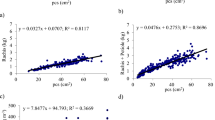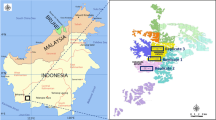Abstract
Peach palm (Bactris gasipaes Kunth) is increasingly grown in the tropics for its heart-of-palm and fruit. Determining fertilization response and diagnosing nutrient status in peach palm may require methods that consider the particularities in nutrient acquisition and recycling of perennial crops. Responses to nutrient additions, and the diagnostic value of soil and foliar analyses were examined in three field experiments with three-year old peach palm stands on Oxisols in Central Amazonia. To diagnose P-deficiency levels in soils, samples from 0–5 cm and 5–20 cm depth were analyzed for available P by different methods (Mehlich-1, Mehlich-3 and Modified Olsen). The second and fifth leaves were analyzed to assess N, P and K deficiencies. Field experiments involved several combinations of N (from 0 to 225 kg ha−1 yr−1), K (from 0 to 225 kg ha−1 yr−1) and P (from 0 to 59 kg ha−1 yr−1). Palms on control plots (unfertilized) and those receiving 225 kg ha−1 yr−1 N and 2 Mg ha−1 of lime yielded between 4 and 19% of the maximum growth which was obtained with N, P and K applications. In one of the experiments, yield of heart-of-palm was positively related to N additions at the lowest levels of P (8.6 kg ha−1 yr−1) and K (60 kg ha−1 yr−1) additions. In one experiment, critical leaf N level was 2.5% for the second leaf and 2.2% for the fifth leaf. Some growth responses to P additions at constant N and K levels were observed (e.g., 797 kg ha−1 yr−1 of heart-of-palm with 39.3 kg ha−1 yr−1 of applied P, and 632 kg ha−1 yr−1 of heart-of-palm with 10.9 kg ha−1 yr−1 of applied P in one experiment, and 2334 kg ha−1 yr−1 of heart-of-palm with 39.3 kg ha−1 yr−1 of P and 1257 kg ha−1 yr−1 of heart-of-palm with 19.7 kg ha−1 yr−1 of P in another trial). In the experiment for fruit production from peach palm, total plant height did not respond to P additions between 19.7 and 59 kg ha−1 yr−1 and K additions between 75 and 225 kg ha−1 yr−1. Leaf P levels were found to be above the proposed critical levels of 0.23% for the third leaf and 0.16% for the fifth leaf. Plants in this experiment, however, showed evident symptoms of Mg deficiency, which was associated with a steep gradient of increasing Mg concentration from the fifth leaf to the second leaf. Standard leaf diagnostic methods in most cases proved less useful to show plant N and P status and growth responses to N and P additions. Soil P determined by common extractions was in general too variable for prediction of growth.
Similar content being viewed by others
References
Amalu U.C., Ataga D.O. and Omoti U. 1988. The distribution of nutrient elements in the leaves of Nigerian Tall coconuts. Niger J. Palms Oil Seeds 9: 2-15.
Ares A., Cox F., Molina E., Falcao N., Yost R.S., Yuyama K. et al. 2002. Requerimientos de fósforo y respuesta a la fertilización fosforada del palmito en vivero y en plantación. Proceedings International Meeting on Design of Decision Support Tools for Integrated Nutrient Management. Guápiles, Costa Rica, January 7-9, pp. 30-44.
Awada M. 1976. Relation of phosphorus fertilization to petiole phosphorus concentrations and vegetative growth of young papaya plants. Trop. Agricult. 53: 173-181.
Bovi M.L.A. 1998. Palmito pupunha: Informações basicas para cultivo, Boletim Técnico 173. Instituto Agronômico, Campinas, Brazil.
Bovi M.L.A. and Cantarella H. 1997. Pupunha para extracao de palmito. In: Raij B.V., Cantarella H., Quaggio J.A. and Cangiani Furlani A.M. (eds), Recomendações de adubação e calagem para o estado de São Paulo. Boletim Técnico no. 100. Instituto Agronômico, Campinas, Brazil, pp. 240-242.
Bovi M.L.A., Tucci M.L.S., Spiering S.H., Godoy G. and Lambais M.R. 2000. Biomass accumulation and arbuscular mycorrhizal colonization in pejibaye (Bactris gasipaesKunth) as a function of NPK fertilization. Acta Hort. 513: 153-167.
Brasil E.C. and Muraoka T. 1997. Extratores de fósforo em solos da Amazônia tratados com fertilizantes fosfatados. Rev. Bras. Cien. Solo 21: 599-606.
Broschat T.K. 1997. Nutrient distribution, dynamics, and sampling in coconut and Canary Island date palms. J. Am. Soc. Hort. Sci. 122: 884-890.
Cai T.T., Olsen T.W., Yost R.S. and Silva J.A. 1997. Performance indices for tests of soil nutrient status: extractable phosphorus. Commun. Soil Sci. Plant Anal. 28: 329-339.
Chapman H.D. and Pratt P.F. 1973. Métodos de análisis para suelos, plantas y aguas. Editorial Trillas, Mexico, 195 pp.
Clement C.R. 1989. The potential use of the pejibaye palm in agroforestry systems. Agrofor. Syst. 7: 201-212.
Cravo M.S. and Smyth J.T. 1997. Manejo sustentado da fertilidade de um Latossolo da Amazonia Central sob cultivos sucesivos. Rev. Bras. Cien. Solo 2: 607-616.
Da Silva F.B. and Raij B.V. 1996. Avaliação da disponibilidade de fósforo, por diversos extratores, em amostras de solos cultivados com cana-de-açúcar. Rev. Bras. Cien. Solo 20: 83-90.
Da Silva F.B. and Raij B.V. 1999. Disponibilidade de fósforo em solos avaliada por diferentes extractores. Pesq. Agrop. Bras. 34: 267-288.
Deenik J., Ares A. and Yost R.S. 2000. Fertilization response and nutrient diagnosis in peach palm (Bactris gasipaes): a review. Nutr. Cycl. Agroecosyst. 56: 195-207.
Diaz Romeu R. and Hunter A. 1978. Metodología de muestreo de suelos, análisis químico de suelos y tejido vegetal e investigación en invernadero. CATIE, Turrialba, Costa Rica.
Gama Pacheco R., Cardoso A.A., Barros N.F., Martinez H.P. and Bovi M.L.A. 1997. Crescimento de mudas de pupunha (Bactris gasipaesH.B.K.) em resposta a calagem e as relacoes Ca/Mg do solo. Proceedings Brazilian Soil Congress. Rio de Janeiro, Brazil, p. 26.
Guzmán P. 1985. Nutrición y fertilización de pejibaye. Respuesta del pejibaye para palmito a la aplicacion de N-P-K. étimo informe de labores de diversificación agrícola. ASBANA, Costa Rica, pp. 41-46.
Herrera W. 1989. Fertilización del pejibaye para palmito. Serie Técnica Pejibaye. Universidad de Costa Rica, San José Boletín Informativo 1: 1-8.
Jongschaap R. 1993. Palmito (Bactris gasipaesH.B.K.) growth and management in the humid lowlands of the Atlantic zone of Costa Rica. Report No. 60. Centro Agronómico Tropical de Inves tigación y Enseñanza (CATIE), Agricultural University Wageningen, Ministerio de Agricultura y Ganadería de Costa Rica.
Lopes Reis E. 1997.Respostas da pupunheira ao NPK na produção de palmito no sul da Bahia. Expanded Abstract 26th Brazilian Soil Science Congress. Rio de Janeiro, Brazil.
McGrath D.A., Comerford N.B. and Duryea M.L. 2000. Litter dynamics and monthly fluctuations in soil phosphorus availability in an Amazonian agroforest. For. Ecol. Manage. 131: 167-179.
Mehlich A. 1953. Determination of P, K, Na, Ca, Mg and NH4. Soil Test Div Mimeo, Department of Agriculture, Raleigh, North Carolina.
Mehlich A. 1984. Mehlich no. 3 extractant: A modification of Mehlich no. 2 extractant. Commun. Soil Sci. Plant Anal. 15: 1409-1416.
Meynard J.M., Aubry C., Justes E. and Le Bail M. 1997. Nitrogen diagnosis and decision support. In: Lemaire G. (ed.), Diagnosis of Nitrogen Status in Crops. Springer-Verlag, Berlin, pp. 147-161.
Molina E. 1999. Suelos, nutrición mineral y fertilización. In: Mora Urpí J. and Gainza Echeverría J., Palmito de pejibaye (Bactris gasipaesKunth): Su cultivo e industrialización. Editorial de la Universidad de Costa Rica, San José, Costa Rica.
Molina E. and Cabalceta G. 1990. Correlación de diferentes soluciones extractoras en Vertisoles y Ultisoles de Costa Rica. Agronomía Costarricense 14: 37-44.
Mora Urpí J., Weber J.C. and Clement C.R. 1997. Peach palm, Bactris gasipaesKunth. Promoting the conservation and use of underutilized and neglected crops 20. International Plant Genetic Resources Institute, Rome, Italy.
Moreira Gomes J.B., Menezes J.M. and Viana P. 1987. Efeito de níveis de adubação e espacamento na produção de palmito de pupunheira em solo de baixa fertilidade na região de Ouro Preto D'Oeste. Proceedings of National Meeting of Researchers on Palmito, March 26-28. Curitiba, Brazil.
Murphy J. and Riley J.R. 1962. A modified single solution method for the determination of phosphate in natural waters. Anal. Chim. Acta 27: 31-36.
Nelson D.W. and Sommers L.E. 1972. Determination of total nitrogen in plant material. Agron. J. 65: 109-112.
Novais R.F. 2000. Diagnosis of soil nutrient constraints and recommendations for lime, nitrogen and phosphorus in Brazil. In: Osmond D.L., Metra-Corton T., Smyth T.J., Yost R.S. and Reid W.S. (eds), Decision processes for determining diagnostic and predictive criteria for soil nutrient management. Workshop Proceedings. SMCRSP Technical Bulletin 2000-03, Maligaya, Philippines, pp. 66-71.
Pérez J., Szott L.T., McCollum R.E. and Arévalo L. 1993. Effect of fertilization on early growth of pijuayo (Bactris gasipaesHBK) on an Amazon Ultisol. In: Mora Urpí J., Szott L.T., Murillo M. and Patiño M. (eds), Proc IV Congreso Internacional sobre Biología, Agronomía e Industrializacion del Pijuayo. Editorial la Universidad de Costa Rica, San José, Costa Rica, pp. 209-223.
Raij B.V. 1978. Seleção de métodos de laboratório para avaliar da disponibilidade de fósforo em solos. Rev. Bras. Cien. Solo 2: 1-9.
SAS Institute Inc. 1989. SAS/STAT User's Guide, version 6, 4th edn, Vol. 2. SAS Institute Inc., Cary, North Carolina.
Schroth G.R., Seixas L.F., Silva Lda T. and Zech W.G. 2000. Nutrient concentration and acidity in ferralitic soil under perennial cropping, fallow and primary forest in central Amazonia. Eur. J. Soil Sci. 51: 219-231.
Smethurst P.J. 2000. Soil solution and other soil analyses as indicators of nutrient supply: a review. For. Ecol. Manage. 138: 397-411.
Soil Survey Staff 1999. Soil Taxonomy. Basic System of Soil Classification for Making and Interpreting Soil Surveys. USDA/NRCS Agriculture Handbook No. 436. USDA, Washington, DC.
Webb M.J., Reddell P., Hambleton A. and Robson K. 2000. Growth response of four tropical plantation timber species to increasing phosphorus supply and assessment of phosphorus requirements using foliar analysis. New Forests 20: 193-211.
Yost R., Ares A., Bajita J. and Wang X. 1999. Diagnosing nutrient deficiencies. In: Osmond D.L., Metra-Corton T., Smyth T.J., Yost R.S. and Reid W.S. (eds), Decision processes for determining diagnostic and predictive criteria for soil nutrient management: Workshop Proceedings. SMCRSP Technical Bulletin 2000-03, Maligaya, Philippines., pp. 107-119.
Yuyama K. 1997. Sistemas de cultivo para produção de palmito da pupunheira. Horticult. Bras. 15: 191-198.
Author information
Authors and Affiliations
Rights and permissions
About this article
Cite this article
Ares, A., Falcao, N., Yuyama, K. et al. Response to fertilization and nutrient deficiency diagnostics in peach palm in Central Amazonia. Nutrient Cycling in Agroecosystems 66, 221–232 (2003). https://doi.org/10.1023/A:1024458823052
Issue Date:
DOI: https://doi.org/10.1023/A:1024458823052




